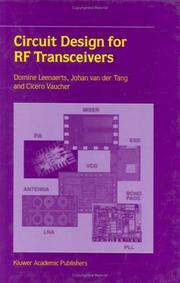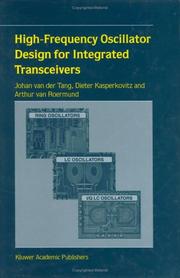| Listing 1 - 6 of 6 |
Sort by
|
Book
ISBN: 9038619707 9789038619705 Year: 2002 Publisher: Eindhoven Technische Universiteit Eindhoven
Abstract | Keywords | Export | Availability | Bookmark
 Loading...
Loading...Choose an application
- Reference Manager
- EndNote
- RefWorks (Direct export to RefWorks)
Digital
ISBN: 9781402065347 Year: 2008 Publisher: Dordrecht Springer Science+Business Media B.V
Abstract | Keywords | Export | Availability | Bookmark
 Loading...
Loading...Choose an application
- Reference Manager
- EndNote
- RefWorks (Direct export to RefWorks)
Spectrometric and optical chemical analysis --- Electronics --- Electrical engineering --- elektronica --- elektrische circuits --- fysicochemie --- spectrometrie

ISBN: 9780792375517 0792375513 9780306479786 0306479788 Year: 2001 Publisher: Boston, Massachusetts : Kluwer Academic Publishers,
Abstract | Keywords | Export | Availability | Bookmark
 Loading...
Loading...Choose an application
- Reference Manager
- EndNote
- RefWorks (Direct export to RefWorks)
Circuit Design for RF Transceivers covers key building blocks which are needed to make an integrated transceiver for wireless and cellular applications, that is low-noise amplifiers, mixers, voltage controlled oscillators, RF power amplifiers and phase-locked loop systems. Starting from detailed RF concepts and specifications, the authors discuss the circuits in detail and provide solutions to many design problems. The circuits are implemented in a wide range of modern technology processes. Production requirements are taken into account, and measurement results are presented and discussed. Several of the presented circuits are used in IC products. The text also includes several RF technologies (for example double-poly, Silicon-on-Anything, SiGe-bipolar, RF-CMOS, etc.) and microwave design techniques, such as transmission line concepts. In addition, the problem of connecting the RF signals on-chip to the PCB and to the antenna will be discussed, including the influence of the package, ESD and bond pads. The contents of Circuit Design for RF Transceivers 2nd edition are based on research activities carried out at Philips Research. Many internal and external publications contributed to make the presented material state-of-the-art. The book is written for people who have a basic knowledge of analogue IC design. The second edition of this successful 2001 RF Circuit Design book has been updated, latest technology reviews have been added as well as several actual case studies. Due to the authors being active in industry as well as academia, this should prove to be an essential guide on RF Transceiver Design for students and engineers.
Radio circuits --- Radio --- Circuits radio --- Design and construction. --- Transmitter-receivers --- Conception et construction --- Emetteurs-récepteurs --- Design and construction --- Computer engineering. --- Engineering. --- Radio - Transmitter-receivers - Design and constru. --- Systems engineering. --- Electrical & Computer Engineering --- Engineering & Applied Sciences --- Electrical Engineering --- Electrical engineering. --- Electronic circuits. --- Circuits and Systems. --- Electrical Engineering. --- Electric engineering --- Engineering --- Electron-tube circuits --- Electric circuits --- Electron tubes --- Electronics --- Telephone, Wireless --- Wireless (Radio) --- Wireless telephone (Early radio) --- Communication and traffic --- Telecommunication --- Telegraph, Wireless --- Radio circuits - Design and construction --- Radio - Transmitter-receivers - Design and construction

ISBN: 1280459492 9786610459490 0306487160 1402075642 Year: 2003 Publisher: Boston : Kluwer Academic,
Abstract | Keywords | Export | Availability | Bookmark
 Loading...
Loading...Choose an application
- Reference Manager
- EndNote
- RefWorks (Direct export to RefWorks)
High-Frequency Oscillator Design for Integrated Transceivers covers the analysis and design of all high-frequency oscillators required to realize integrated transceivers for wireless and wired applications. This includes the design of oscillator types as single-phase LC oscillators, I/Q LC oscillators, multi-phase LC oscillators, and ring oscillators in various IC technologies such as bipolar, BiCMOS, CMOS, and SOI (silicon on insulator). Starting from an in depth review of basic oscillator theory, the authors discuss key oscillator specifications, numerous oscillator circuit topologies, and introduce the concepts of design figures of merit (FOMs) and benchmark FOMs, which assist the oscillator designer during the overall design cycle. Taking advantage of behavioral modeling, the elementary properties of LC oscillators and ring oscillators are analyzed first. A detailed analysis of oscillator properties at circuit level follows taking parasitic elements and other practical aspects of integrated oscillator design into account. Special attention is given to advantages and limitations of linear time invariant (LTI) phase noise modeling, leading to the concept of optimum coupling in I/Q LC oscillators and a simulation method for fast and efficient phase noise optimization in oscillators. In addition, all modern linear time variant (LTV) phase noise theories are covered. As not only phase noise is of high importance to the designer, but optimization of other oscillator properties as well, additional subjects such as various tuning methods of LC oscillators are analyzed, too. Design examples of integrated LC and ring oscillators in the frequency range of 100 MHz up to 11 GHz are thoroughly discussed throughout the book. The clear and structured discussion of basic oscillator properties make High-Frequency Oscillator Design for Integrated Transceivers an excellent starting point for the inexperienced oscillator designer. The detailed analysis of many oscillator types and circuit topologies, the discussion of numerous practical design issues together with fast optimization methods, and more than 200 carefully selected literature references on oscillator literature, LC oscillator and ring oscillator designs make this book a very valuable resource for the experienced IC designer as well.
Oscillators, Electric --- Radio --- Design and construction. --- Transmitter-receivers --- Telephone, Wireless --- Wireless (Radio) --- Wireless telephone (Early radio) --- Electric oscillators --- Engineering. --- Electrical engineering. --- Electronic circuits. --- Circuits and Systems. --- Electrical Engineering. --- Communication and traffic --- Telecommunication --- Telegraph, Wireless --- Electric apparatus and appliances --- Electric machinery --- Systems engineering. --- Computer engineering. --- Computers --- Engineering systems --- System engineering --- Engineering --- Industrial engineering --- System analysis --- Design and construction --- Electric engineering --- Electron-tube circuits --- Electric circuits --- Electron tubes --- Electronics
Book
ISBN: 9400701829 9400701837 Year: 2010 Publisher: Dordrecht : Springer,
Abstract | Keywords | Export | Availability | Bookmark
 Loading...
Loading...Choose an application
- Reference Manager
- EndNote
- RefWorks (Direct export to RefWorks)
Wireless sensor networks have the potential to become the third wireless revolution after wireless voice networks in the 80s and wireless data networks in the late 90s. Unfortunately, radio power consumption is still a major bottleneck to the wide adoption of this technology. Different directions have been explored to minimize the radio consumption, but the major drawback of the proposed solutions is a reduced wireless link robustness. The primary goal of Architectures and Synthesizers for Ultra-low Power Fast Frequency-Hopping WSN Radios is to discuss, in detail, existing and new architectural and circuit level solutions for ultra-low power, robust, uni-directional and bi-directional radio links. Architectures and Synthesizers for Ultra-low Power Fast Frequency-Hopping WSN Radios guides the reader through the many system, circuit and technology trade-offs he will be facing in the design of communication systems for wireless sensor networks. Finally, this book, through different examples realized in both advanced CMOS and bipolar technologies opens a new path in the radio design, showing how radio link robustness can be guaranteed by techniques that were previously exclusively used in radio systems for middle or high end applications like Bluetooth and military communications while still minimizing the overall system power consumption.
Low power radio. --- Sensor networks. --- Wireless communication systems. --- Wireless sensor networks. --- Electrical & Computer Engineering --- Engineering & Applied Sciences --- Electrical Engineering --- Frequency synthesizers. --- Radio frequency oscillators. --- Engineering. --- Solid state physics. --- Microwaves. --- Optical engineering. --- Electronic circuits. --- Circuits and Systems. --- Solid State Physics. --- Microwaves, RF and Optical Engineering. --- Electron-tube circuits --- Electric circuits --- Electron tubes --- Electronics --- Mechanical engineering --- Hertzian waves --- Electric waves --- Electromagnetic waves --- Geomagnetic micropulsations --- Radio waves --- Shortwave radio --- Physics --- Solids --- Construction --- Industrial arts --- Technology --- RF oscillators --- Oscillators, Electric --- Synthesizers, Frequency --- Frequency changers --- Oscillators, Crystal --- Signal generators --- Systems engineering. --- Engineering systems --- System engineering --- Engineering --- Industrial engineering --- System analysis --- Design and construction
Book
ISBN: 9781402065347 Year: 2008 Publisher: Dordrecht Springer Netherlands
Abstract | Keywords | Export | Availability | Bookmark
 Loading...
Loading...Choose an application
- Reference Manager
- EndNote
- RefWorks (Direct export to RefWorks)
The design and use of multi-standard RF transceivers is the way to increase hardware flexibility and functionality, as well as to improve the flexibility of set-makers on the market. In the design of multi-standard RF transceivers the efforts will be directed towards improvement of hardware reusability, reconfigurability, programmability and flexibility. This will result in the launching of a software-defined radio. Since the radio environment is variable, the application of adaptivity in RF transceivers results in the reduction of their power consumption. Eventually, it is reasonable to believe that RF front-ends will be smart in the sense that they will be able to monitor the radio environment and to adapt themselves to the changes in this environment paving the way for a cognitive radio. Adaptive Multi-Standard RF Front-Ends investigates solutions, benefits, limitations and costs related to multi-standard operation of RF front-ends and their adaptivity to variable radio environments. Next, it highlights the optimization of RF front-ends that allow achieving of maximal performance with a certain power budget while targeting full integration. Also, it investigates possibilities for low-voltage low-power circuit topologies in CMOS technology. The concepts and considerations presented in this book have been validated through the design and implementation of the reconfigurable multi-band DECT/Bluetooth RF front-end in 0.18 um CMOS technology. The successful design and implementation of the reconfigurable DECT/Bluetooth RF front-end is the result of systematic approach through all the steps in the design flow of a multi-standard front-end starting with the system level design, continuing with the circuit level design and implementation, and ending with the validation based on measurements.
Spectrometric and optical chemical analysis --- Electronics --- Electrical engineering --- elektronica --- elektrische circuits --- fysicochemie --- spectrometrie
| Listing 1 - 6 of 6 |
Sort by
|

 Search
Search Feedback
Feedback About UniCat
About UniCat  Help
Help News
News